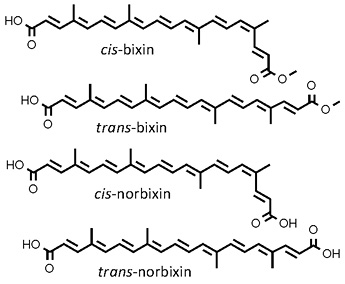 Bixa orellana
Bixa orellana
annatto • achiote • roucou
Back to “Spices: annatto (Bixa orellana)s”
Bixa orellana L. (Bixaceae); annato (Afrikaans); yan zhi shu (Chinese); rocou, roucou, annatto (French); Annato (German); kesumba (Indonesian); annatto (Italian); jarak belanda, kesumba (Malay); atsuete (Philippines); urucú, urucum (Portuguese); achiote, achiotillo (Spanish); kam tai (Thai)
DESCRIPTION The seeds are cone-shaped and about 4 mm (just over ⅛ in.) long, with a bright red seed coat containing a natural pigment (annatto or roucou).1 They have practically no taste or aroma.
THE PLANT It is a distinctive shrub or small tree bearing heart-shaped leaves and clusters of pink flowers. Between 10 and 50 seeds are borne in each of the oblong, spiny pods.
ORIGIN Bixa is indigenous to tropical America. It has been used as ritual body paint by Native Americans and is known as achiote, annatto, bijol and roucou (achiotl is the original Aztec name). In the 17th century, the Spanish introduced it to almost all warm regions of the world.1
CULTIVATION Any tropical or frost-free subtropical area with a high rainfall and well-drained soil is suitable for commercial production, preferably with a dry period during seed ripening.2,3 High-yielding clones are selected and grown from cuttings but most commercial trees are propagated from seeds even though seeds and bixin yields may then be quite variable.2,3 Plantations can be found in many Central American countries and in Africa and Asia. Brazil is a major producer for local consumption but Peru and Kenya are responsible for most of the annual ca. 7 000 tons in international trade. Consumption has increased in recent years because of bans on synthetic food dyes (it is a natural alternative to tartrazine) and various applications in confectionery, soaps and cosmetics.
HARVESTING Fruits are harvested (by knife or secateurs) when they start to split open and before the seeds are exposed to sunlight and rain. Seed yields of around 1 000 to 2 000 kg (2 200 to 4 400 lbs) per hectare (dry weight) are typical.3 The seeds are cleaned by mechanical sieving and winnowing, taking care to avoid abrasion damage.
CULINARY USES Annatto is used mainly to give an attractive yellow colour to margarine, butter, cheese, processed salad oils and smoked fish.3 The whole or ground seeds have almost no flavour but are nevertheless important because of the colour it adds to Meso-American and Philippine dishes. It is an essential ingredient of a spice mixture called recado rojo (achiote paste) that is used in marinades and rubs for meat, Mexican cochinita pibil (pork), tascalate (a drink), empanadas and tamales. It takes the place of saffron in Jamaican akee-fish-and-rice and in many traditional dishes in the Philippines (where it is called atsuete).
FLAVOUR COMPOUNDS The main pigment is a carotenoid called bixin (2 to 3% yield).3,4 It occurs as a mixture of the cis and trans isomers. Seeds are extracted with dilute sodium or potassium hydroxide, resulting in the natural bixin being converted to water-soluble norbixin salt. An alternative is extraction with vegetable oil, giving a suspension of cis- and trans-bixin.3,4

NOTES Annatto very rarely causes food-related allergies in sensitive persons.
1. Ingram, J.S., Francis, B.J. 1969. The annatto tree (Bixa orellana L.) – a guide to its occurrence, cultivation, preparation and uses. Tropical Science11: 97–102.
2. Venter, M.W. 1981. The cultivation of Bixa orellana L. Crop Production (South Africa) 5: 87–89.
3. Henry, B.S. 1992. Natural food colours. In: Hendry, G.A.F., Houghton, J.D. (Eds), Natural Food Colourants (2nd ed.), pp. 40–79. Blackie Academic & Professional, Glasgow.
4. Preston, H.D., Rickard, M.D. 1980. Extraction and chemistry of annatto. Food Chemistry 5: 47–56.